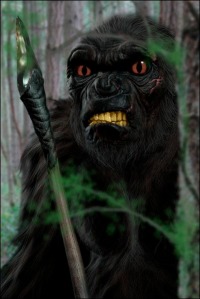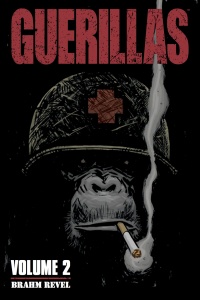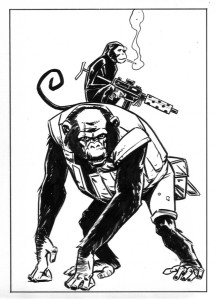
Sometimes it’s easy to forget what came before.
I’m late on this scene, but I don’t care:
Being a blogger – and to a greater extent; human being – that constantly emphasizes strange and preposterous things, you’d think I’d be pretty accepting of harebrained theories. I’ll readily admit to the left-field ideas I throw out in my free time.
I should be the last person to tell you that, well… maybe speculation can get a little out of control.
Maybe it’s this close affiliation with spec fiction that leaves me so protective of the subject; but when I heard about a certain “hypothesis”, I couldn’t help but get a little worked up.
It goes like this. A gentleman by the name of Danny Vendramini came up with this idea that ‘radically alters our perception of our closest hominid relatives.’ Immediately, I’m fully aboard with the idea. This is the crap I live for. Physical Anthropology! Let’s come at this puppy sideways!
However, I was thusly, and rather rudely thrown from the bandwagon. You can view his website, Them and Us here and immediately see why. Just one click in and my blood pressure did things god never intended it to do.
Danny posits some fairly (to put it mildly) outlandish interpretations about Neanderthal evolution, physiology and behavior, while throwing caution to the wind and completely disregarding scientific facts built up by paleontologists and anthropologists since science began compiling them in 1856.
All this from a man with no formal scientific training; from what I could glean on his site. Other than being an ‘armchair researcher”, Mr. Vendramini claims to be a member of the Independent Scholars Association of Australia Incorporated.
Well hey! I’ve been doing the same kind of stuff all my life. Sure, I never signed up for any fancy associations, but I’ve done plenty of layman-level reading on the subject of hominid evolution! I collect replica hominid skulls too!

Anthropological street cred? I got that.
I’ve got as much credentials to tackle the subject as he does. As much Wikipedia “hangin’ ten” time. I can also claim to have “studied” Neanderthals for longer than Mr. Vendramini’s own “ten years.”
So when I finally viewed the youtube video featuring his theory, I felt compelled to stand up for the science-buffs, speculators and average-joe-anthropologists of the world. Someone has to show those real scientists that all of their hard work isn’t totally in vain. Most of us actually listen to what you guys have to say.
Without further ado; here’s my take on the credulous ideas put forward in Danny Vendramini’s video. As it stands, I’m not particularly impressed to read his book. The flag is a little too red for my tastes.
Again. This is a review of the man’s video linked above.
—
Right off the bat: We have Danny asserting that “There is no sound archeological evidence that Neanderthals looked human,” and “soft tissues aren’t preserved in the fossil record.”
So far so good.
He then firmly readies his foot and his mouth by proposing to use Archeological, Genetic, and Foresic Evidence! to help prove his theories.
Anthropomorphism is tarried out to explain why all modern interpretations of Neanderthals feature “human-looking” and “shaven-faced” reconstructions. I find it funny that he himself describes anthropomorphism as “Humans attributing human characteristics on animals” when Neanderthals are indeed placed within the genus homo: ergo, human. But that’s beside the point.

Mr. Lok asks, “Why so stingy with Armani, bro?”
This is when we reach the first of the video’s blatant misdirections. Vendramini claims that Neanderthal eyes “were in a different position in their skulls compared to humans.” As persuasive as his ‘reassembled George Clooney’ argument tries to be… Neanderthals most certainly didn’t have their eye sockets located in the middle of their foreheads.
Neanderthal skulls were shaped completely differently from their h. sapiens counterparts. They didn’t have chins for one. The crown of the skull was also much less pronounced. The bulk of the brain was situated in a much more horizontal plane when compared to the more vertical sapiens arrangement.
Prognathous jaws also stretched out the face, increasing its comparative size to sapiens. Neanderthals were much more robust. Less neotenized than our monkey-baby faced selves.
When Vendramini shows his side by side comparisons: top of head to bottom jaw, he fails to take these characteristic differences of the skulls into account.
Covert distortions like this are common throughout the entire video. I caught a point where the articulated skeletons of neanderthalensis and sapiens were shown shoulder-to-shoulder; Neanderthals depicted as the larger of the pair.
They weren’t. I always thought that short and stocky Neanderthals were common knowledge. Has ignorance crept up on me again?
Next we branch off into all out falsities. If I weren’t so nice, I’d call them straight up lies.
Vendramini proceeds to describe the particulars of sapiens/neanderthalensis evolution. He claims that the two hominids diverged and evolved in total isolation over the course of “over half a million years.” Fact check time. If you grab any book on the subject, you will learn that it is currently thought that anatomically modern humans and Neanderthals branched off from an ancestral form of homind, probably homo heidelbergensis. Neanderthals diverged from a population 300,000 years ago in Europe while sapiens evolved from a group that had remained in Africa some 200,000 years ago.

Doesn’t this scream out scientific integrity?
That’s 100,000 years. Kinda strengthens the idea of similarity a bit, don’t it? Vendramini’s whole argument on this point seems to hinge on the fact that Neanderthals were so far removed and in a ‘naturally inhospitable’ environment, that evolutionary change would have favored dissimilarity. I’m all for variation, but the science is clear on this point.
We’ll touch on this, as Vendramini comes back to this later.
Vendramini goes on to solidify the blindingly obvious by saying that “Neanderthals were members in the order of primates.”
His usage of the term here is vague. I’m certain he’s aware that modern humans are primates as well. I’d give him the benefit of the doubt, but it seems to me like he’s trying to steer the topic (not so gently I might add) into his Neanderthal’s similarity with apes.
But we’re categorically apes as well, so I’m not sure what he’s trying to prove here by saying Neanderthals would look like primates. This highlights an apparent disconnect that Vendramini has with the subject of human evolution. Either that, or he’s trying to play to the public’s misconception and ignorance of primate phylogenic diversity.
Then he states that humans no longer look like their “primate ancestors” because of completely unique ecological and environmental circumstances. He doesn’t elaborate. Thus, according to Vendramini, humans evolved non-apish hairless bodies within the last 500,000 years; the time of diversification which he stated earlier. If I have his hypothesis straight, of course.
This is all kinds of wrong. Hominid nakedness has been traced to long before.
Note: The Neanderthal skull fitting into the chimpanzee profile falls apart when you realize the spinal column is all outta-whack.
Next, he brings up his consultations with Arturo Balseiro: a freelance artist and obvious FX maestro. Balseiro has no apparent history of forensic reconstruction, and no background in the field of physical anthropology. But his works do look amazing. Moving on.

Do you really need to sensationalize this badass?
Environment: Ice Age!
So we’re back here again. Vendramini likes to describe the “frozen glacial wasteland” that was ice age Europe. He does so a few times, as it draws heavily into his ‘Neanderthals be fuzzy’ argument. It’s “the most inhospitable environment ever occupied by hominids” after all. The way he expounds would have you believe Europe was all but a popsicle back in those days. But let us stray back towards the facts.
The words Mr. Vendramini uses over and over is the colloquial term, Ice Age. However, the scientific term for an Ice Age is an extended period of Earth’s geologic time where sheets of ice cover much of the globe. What Vendramini is undoubtedly referring to in the video is the ‘last glacial period’. Also called a glaciation. The most recent period began some 110,000 years ago and ended 10,000 or so years ago. ‘Maximum glaciation’ or, the furthest reach of the “frozen wasteland” was achieved 22,000 years ago.
Ancestors of the Neanderthals probably arrived in Europe during an interglacial period around 300,000 years ago, between the 2nd and 3rd Pleistocene glaciations, working back. Early members of neanderthalensis were undoubtedly molded by the advancing and retreating glacial waves, but most of Neanderthal-country remained open, unlocked and untouched by glaciers.
But yes. Things did get pretty nippy.
The whole problem of body hair is kind of a non-issue. Vendramini’s assertion that “Well since all the European animals were furry, Neanderthals were too” comes across as lazy. This falls into the category of the thin eye-slits featured in his reconstruction. I’m sure the idea is, “So, like, nocturnal predators like cats got ‘em. Why not my super-thals?”
Having recently read All Yesterdays, I’ve been left me with an extremely high bar for speculative reaching. All Yesterdays did it right. What’s more, the book has supplied me with some fantastic ammunition against not-so-good attempts at guesswork. Namely a section where future-extinct iguanas are deduced to be furry because… “Like, all the other animals around were furry!”
Moral is, you can’t ignore phylogenic placement, no matter how awesome an iguana would be to comb.
Rapid fire time:
Neanderthals ate meat. Yes. A lot of it. But not exclusively. They also got cooked vegetables stuck in their teeth.
The rest of the video degenerates into a slew of hypotheses and proclamations that have no basis.
Cannibalism makes them monsters. Nevermind the Donner party was pioneered by human beings.
“Neanderthals were six times stronger than humans,” pulled out of thin air.
Theory of hunting at night, harkening back to ‘proof’ of large eyes that Vendramini made up earlier.
Maintains that raping and pillaging is the only explanation for Neanderthal genes in the modern human genome.
Vendramini’s only real ‘proof’ of any of this is legends and myths of monsters. A kind of ancestral neurosis passed down to us from those gory days of yore.
At this point I’d had enough. Strange when I think about how much I’d love to see a gorilla with weapons. I should really be in heaven, but instead I feel drained. There’s something ‘inventively sapping’ about the Them and Us hypothesis.

I like imagination. I can give a guy points for trying something new and interesting. He’s obviously put a lot of time into this project… though he’s obviously overlooked (ignored) a few (major) details. Shaking up the status quo is always healthy, but I kind of imagine a little bit of merit and artistic integrity should go along with your suppositions.
That’s why I came away from this with so much spite. The betrayal of it. The nerve of spouting lies unabashed.
I’ve always found that truth supplies the real depth of meaning and authenticity to works of fiction. In wildlife, biota, behavior – truth is stranger than fiction. There’s so much wonder to tap into in the natural world.
Just be honest with it.
The thin veneer of science is pretty wobbly on this one.
I mean, how serious can you take a mug like that?













